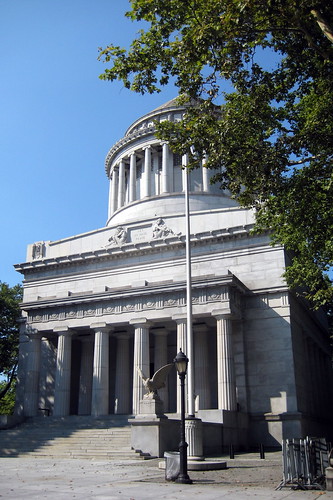NYC – Morningside Heights: General Grant National Memorial

Government Funding
Image by wallyg
General Grant National Memorial, better known as Grant’s Tomb, dramatically situated at the north end of Riverside Park at 122nd Street, is a mausoleum containing the bodies of Ulysses S. Grant(April 27, 1822 – July 23, 1885), an American Civil War General and the 18th President of the United States, and his wife, Julia Dent Grant (1826–1902).
Ohio-born Hiram Ulysses Grant, trained at West Point, served in the Mexican-American War as a Lieutenant before achieiving fame as the leading Union general in the American Civil War. He first reached national prominence by by taking Forts Henry and Donelson in 1862–the first Union victories. The following year, his campaign ending in the surrender of Vicksburg secured control of the Mississippi and, with the victory at Gettysburg, turned the tide of the war. Named commanding general of the Federal armies in 1864, he accepted the surrender of Robert E. Lee at Appomattox Court House in 1865.
Grant was elected president in 1868 and became the first to serve two full terms since Andrew Jackson. Leading Radical Reconstruction, he built a powerful patronage-based Republican party in the South, with the adroit use of the army. He took a hard line that reduced violence by groups like the Ku Klux Klan.
Unsuccessful in winning a third term in 1880, and bankrupted by bad investments, Grant found haven in New York before falling terminally ill with throat cancer. He was honored with a large funeral parade, stretching seven miles and including 60,000 marchers before his remains were were entombed in a temporary vault in the park. The granite and marble structure, the second largest mausoleum in the western hemisphere, was dedicated on Grant’s 75th birthday, April 27, 1897. Julia Grant died on December 14, 1902 and her remains were interred beside her husband in a twin sarcophagus.
Architect John Duncan based his neoclassical design on one of the seven wonders of the world, the tomb of Mausolus at Halicarnassus. The monument is adorned by Doric columns on the lower level and a cupola above. It rises 150 feet above the ground and over 280 feet above the banks of the Hudson River. On the facade is the epitaph, "LET US HAVE PEACE"–a quote taken from Grant’s acceptance of the Republican nomination. Allegorical figures probably representing Victory and Peace, sculpted by J. Massey Rhind, are depicted on either side of the sign.
The interior is largely made of Carrara and Lee marble. Inside a ground-level, circular crypt are two sarcophagi, made of red granite from Montello,
Wisconsin and weighing 8½ tons each, are placed inside a circular crypt at ground level. A path around the crypt contains busts of five of Grant’s lieutenants (William Tecumseh Sherman, George Henry Thomas, Edward Otho Cresap Ord, Philip Henry Sheridan, and James Birdseye McPherson), which were added in 1938 as part of a WPA project.
On the four pendentives in the interior are relief sculptures, also by Rhind, with allegorical representation’s of Grant’s birth, Military Life, Civilian Life, and Death. In 1966, Allyn Cox’s mosaic murals, portraying scenes from three of Grant’s greatest campaign, were added to three lunettes inside Grant’s Tomb. The Tomb also contains two reliquary rooms with murals by Dean Fausett featuring classical themes as well as maps depicting the theater of the Civil War. Locations of battles are indicated by crossed sabers. Grant’s battles are indicated with a star. In the center of the reliquary room are bronze trophy cases containing replicas of Civil War battle flags.
In its early days, the Tomb’s annual visitation often exceeded 500,000. In 1928, architect John Russell Pope proposed a number of developments at Grant’s Tomb, but the Great Depression hinder such projects. During the 1950’s, the Grant Monument Association transfered control over Grant’s Tomb to the federal government. The National Park Service took over the site in 1959 and officially named the monument the General Grant National Memorial.
The 1960’s and 1970’s saw mismanagement by the NPS. The monument was scarred by vandalism. and many artifacts were either disposed of intentionally or otherwise lost. In 1972, the NPS spent government funds on the construction of abstract mosaic benches, which have been widely criticized for having little to do with the monument and for detracting from its architectural and aesthetic character. Into the 80’s, the complex became a desolate hangout for drug dealers and homeless. In the late 90’s funding was secured for a thorough renovation.
Grant’s Tomb (interior and exterior) was designated a landmark by the New York City Landmarks Preservation Commission in 1975.
National Register #66000055 (1966)
Federal funds to help bring broadband to rural areas in state
More than 29,000 rural Oklahomans will receive new or expanded broadband Internet services thanks to a $ 45.5 million in federal grants.
Government Funding
Read more on Tulsa World
Ridgewood schools receive federal grant for history education
Ridgewood schools will receive about $ 1 million from the federal government as part of the U.S. Department of Education’s Teaching American History Grants program.
Government Funding
Read more on The Record and Herald News
